Notes on a Treble Crochet Stitch Slipover: Inspirations and Influences
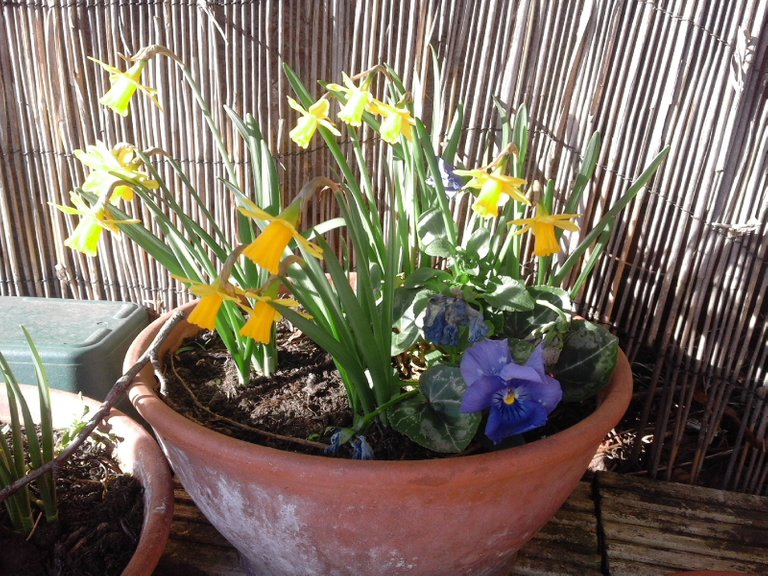
Well, it's a gloomy, overcast day with heavy rain and strong winds, the stormy weather continues. We had a few sunny hours yesterday and the garden was full of bright daffodils, bravely nodding in the breeze. This is their second spring and they are starting to naturalise. Even today, they are shining like a little line of beacons.
I'm glad to be inside, in the warm, where I've been working on my crocheted slipover. Everything came in time for my few days away, and I was able to make my tension square and other samples while I was away. Since returning home, I've been able to put in a few hours in the afternoons and evenings. I'm really enjoying working with the yarn I've chosen, Rowan Creative Linen, some I already had. It's soft to work with and has a slight sheen to to it.
The pattern is interesting, too: I started with a single crochet foundation chain to give a more robust and stretchy edge to the hem; then the pattern is worked simply in treble crochet (UK) with a chain stitch between each treble to give an open grid pattern.

You can see the single crochet foundation chain along the bottom edge, then the grid pattern formed by the pattern. There's two small mistakes as well, which I've left - one at the bottom right (I had made too many stitches and needed to decrease by one) and one on the lefthand side, about halfway up the sample - it looks a bit like a chromosome.
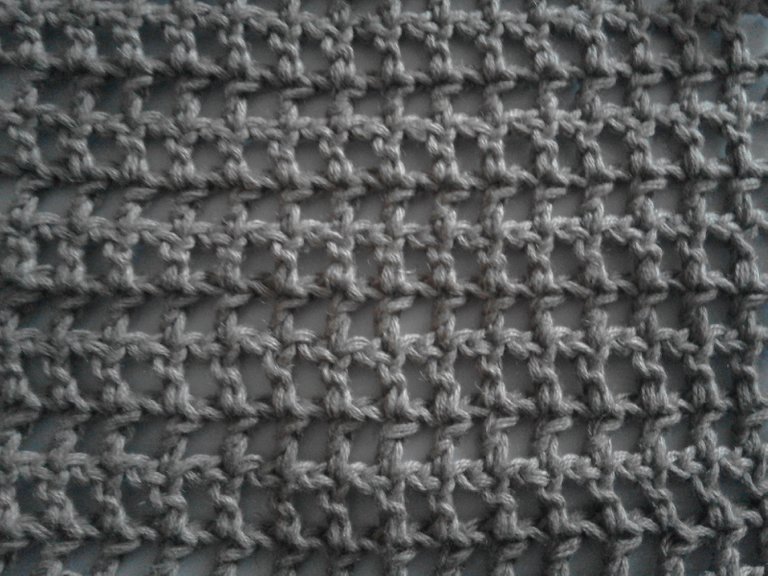
I love the grid pattern - the architectural feel to it, the way the sculptural texture of it creates shadows and highlights, the stitches marching across the pattern like hieroglyphs or other Ancient Writing. I also love the tension between the stitches, each one held in its place by the others.
I haven't yet found the rhythm for my crochet, I'm quite slow, a row takes me between twelve and seventeen minutes, and there is some fiddling about at the end of each row as I look for the correct stitch to join in the turning chain below. I'm maintaining quite a tight tension, as I started that way, it would be easier and more satisfying if I had relaxed into a looser, more expansive tension (a lesson for another time).
I like the thoughts that come into my head when I'm crocheting (or knitting), the ideas and connections that come between what I am making and things that it recalls. I was researching Victor Vasarely as part of my Textend project, and I remembered seeing Supernovae and other Op Art and wondering whether I could create similar effects in crochet.
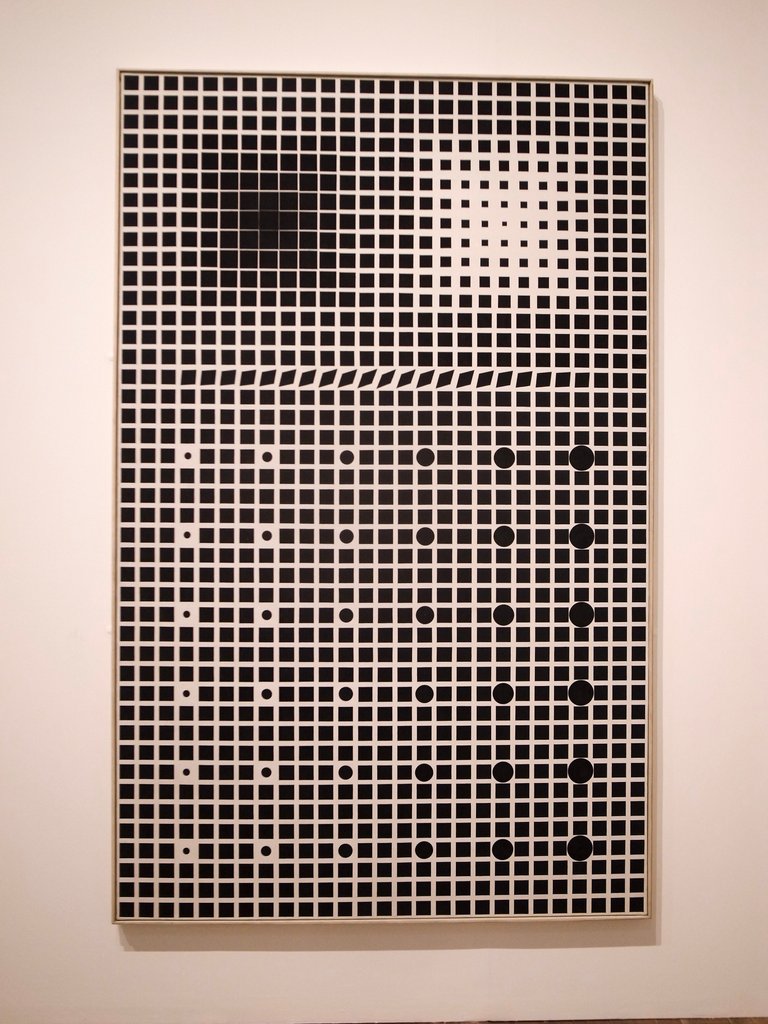
Source Supernovae, 1959-61, Victor Vasarely, Tate Modern. Picture by Msamoeba shared through Creative Commons Licence CC BY-SA 4.0. I saw this work recently on a visit to Tate Modern. Previously, I haven't been captured by such works, although I found them interesting. On this visit, I was more fascinated by them. I had also seen an Op Art quilt which, although I wouldn't want to re-create a particular idea, did open me to the ideas of creating a different kind of optical illusion through stitch.
I was also reminded of some of Anni Albers work, which I had seen in an exhibition at the end of 2018: I wrote about it here and here. The works that kept coming into my head, apart from Ancient Writings, were the printed and embossed works with triangles, inspired by ancient civilizations and buildings:
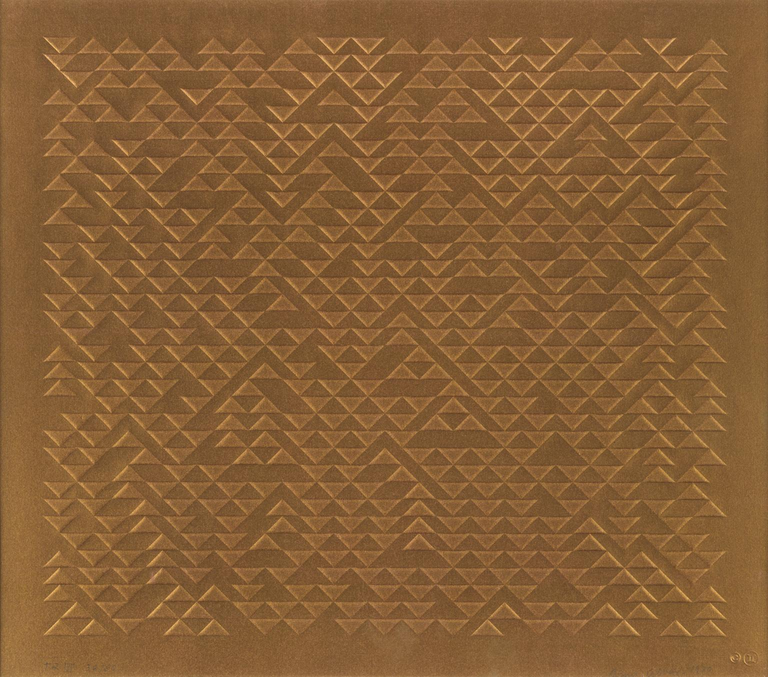
Source TR III, Anni Albers, 1969-70 in Tate Modern
TR III is a square printed and embossed work on paper. It consists of a gold-printed surface into which small, wide-based triangles have been embossed in a tight motif of thirty-six neat rows. Some of the triangles point upwards while others point downwards, and further triangles of similar sizes are created by the unembossed negative spaces between them. Shimmering highlights are formed where the light catches the edges of the printed shapes and where it travels across the smooth gold surface of the composition’s thick border. (Tate Modern)
This work reflects some of the things I was seeing in my own simple crocheted pattern - the reflection of light and creation of shadows, the tension between the triangles, the way new patterns are formed by the placing and inversion of the triangles. I was reminded of the Sceles pattern, with its tall triangles - a uniform pattern changed by the drape of the fabric and how it was underlaid by other fabrics, textures and colours.
My inclination was to stop following the pattern, which is for a mid-thigh slipover for beachwear, and convert it to a cardigan in my usual style - cropped, 3/4 length sleeves, a single button on the front. I also experimented by trying a row of double treble stitches, but I found it wasn't pleasing - it needed the repetition of many rows to acquire the magic. I also thought about the grid as a foundation for weaving and embellishing.
The final image that keeps recurring, even when I was watching Last Tango in Halifax, an engaging Sunday night drama, was the buildings on the Alton Estate in South West London, one of the largest social housing estates in England. Inspired by Le Corbusier's Unite d'Habitation - streets in the sky, cities floating in a sea of green and park land, the Alton Estate sits surrounded by Richmond Park with majestic views from the flats. Some are built on struts, open at ground level, increasing the illusion of a floating city with 13,000 residents living in the sky.
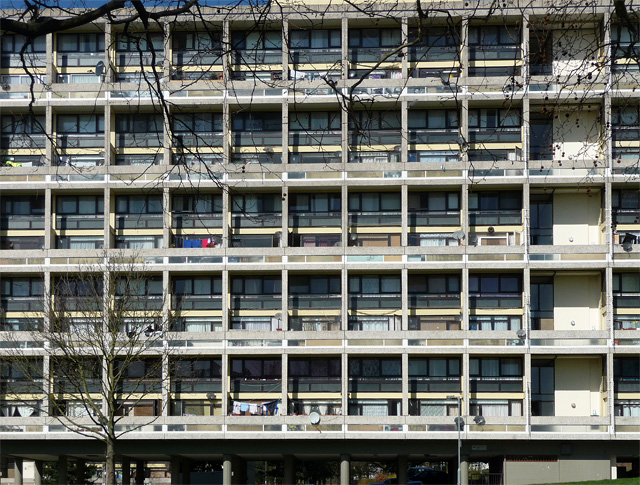
Source A close up of Winchfield House, one of the slab buildings on Alton West Estate, Hinchcliffe Drive, Wandsworth. Photograph taken by Stephen Roberts and shared under Creative Commons Licence CC BY-SA 2.0.
I liked this quote from Anni Albers:
Besides surface qualities, such as rough and smooth, dull and shiny, hard and soft, textiles also includes colour, and, as the dominating element, texture, which is the result of the construction of weaves. Like any craft it may end in producing useful objects, or it may rise to the level of art.
(Anni Albers, On Designing, 1971)
It reminded me of Audrey Coyne and her approach to creating outfits - combining different surfaces, shiny, smooth, textured, plain; different proportions and shapes, playing with the proportions to create illusions; and how she uses colour to bring together an overall impression, to highlight or to distract and divert. Her latest video illustrates this really well.
Now, having reviewed some of these ideas, I've decided to continue with the slipover pattern. I want to see the effects of the drape in a finished piece, and how it looks layered over different fabrics and textures. Separately, I have some more of the same yarn in a different colour for experimenting with some of the ideas I've had.
According to the Bible, Are you one of the apostles of Jesus? Why do you preach?
Watch the Video below to know the Answer...
(Sorry for sending this comment. We are not looking for our self profit, our intentions is to preach the words of God in any means possible.)
Comment what you understand of our Youtube Video to receive our full votes. We have 30,000 #SteemPower. It's our little way to Thank you, our beloved friend.
Check our Discord Chat
Join our Official Community: https://steemit.com/created/hive-182074
Congratulations! Your post has been selected as a daily Steemit truffle! It is listed on rank 15 of all contributions awarded today. You can find the TOP DAILY TRUFFLE PICKS HERE.
I upvoted your contribution because to my mind your post is at least 4 SBD worth and should receive 200 votes. It's now up to the lovely Steemit community to make this come true.
I am
TrufflePig, an Artificial Intelligence Bot that helps minnows and content curators using Machine Learning. If you are curious how I select content, you can find an explanation here!Have a nice day and sincerely yours,

TrufflePigThank you 😊
This post was shared in the Curation Collective Discord community for curators, and upvoted and resteemed by the @c-squared community account.
If you are a community leader and/or contest organizer, please join the Discord and let us know you if you would like to promote the posting of your community or contest.
@c-squared runs a community witness. Please consider using one of your witness votes on us here
Thank you, @c-squared, good to hear from you 😊
I totally get your allusions... the crochet really resembles op art (I right now imagine that you will wear the sweater and than turn very fast, you could transform yourself into an optical illusion :-D )
It is nice to hear your yarn is lovely to work with, this is not always the case with cotton. I remember a project I made for friends where I intensely hated the cotton fabric they gave me, it was so stiff and scratchy 😱
And with the beginning stitch: although I would say I am fairly skilled in crochet, I always use a stitch marker to mark the last/first stitch to not accidentally increase at the beginning of the row. Could this help you too?
I will later watch the video you linked. WHich reminds me... I watched a new show (tried to... too much headache and the show was to feast paced for me at this moment) about sewing and designing on Netflix (Fashion first) and I was in love with some of the designer’s clothes. Especially the participants from China and Korea wore so beautiful clothes in the first episodes (for example a long transparent dress over several layers). Not sure if you now the show already?
Stitch marker is a good idea :) it's about finding the third chain in the turning chain. But I could put a stitchmarker in it when I make the chain, so that would work perfectly 😍
I'm getting more into fashion, I'm finding it more interesting as personal expression ... up till now I've tended to buy clothes to keep warm/cool/covered. So many ideas can be adapted.
I undid my first slipover, I couldn't bear making a whole garment with such an intense tension 😂. I've tried a more relaxed approach and less stitches. Hope you're feeling better 😍❤️💐
I do it exactly as you say: placing the marker the moment I make the turning chain... but honestly, with the new mint cardigan I am no longer using turning chains, I am making this beginning dc variation (and I am fairly sure I got the idea from you, didn’t you wrote about this some time ago?) So far I like this much more than the three chains, but I still put a marker into the completed beginning stitch.
Just to be on the safe side, here is the link
https://www.mooglyblog.com/chainless-starting-double-crochet/
And with the slipover... I am not sure I understand you correctly: Was your fabric to stiff and the process of crochet to uncomfortable because of the high tension? As I am the other way round (everything is too loose - knitting and crochet) perhaps I should send you some stitch relaxing vibes? 😂
I think my tension is so loose because I hold the yarn differently, but I am to lazy too unlearn this (also I can crochet faster this way).
I do not wind the yarn around my little finger, it only lays there. I also do not secure the yarn with my right hand on the hook. Not sure if this helps in any way (and sorry I couldn’t resist a crochet advice)
I am looking forward to your fashion posts and experiments. I love this. Perhaps this helps me to also get a bit more daring 🌈💕
I was anxious to get the tension right, so I was pulling each stitch very tightly, instead getting into a comfortable rhythm. It wouldn't have been a pleasure to keep working so tightly. Even so, the garment was still too big 😂 I experimented with a smaller hook, but it was too small for the yarn and kept snagging the fibres instead of catching it cleanly. So I have decided to make a smaller size with less stitches 😂😂😂 I have only done a few rows so I am not sure yet whether that will work!